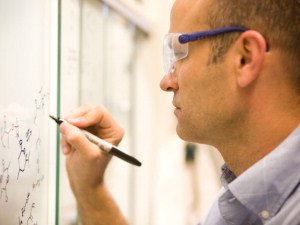Pioneering Polymers

Odds are good that, right now, you are touching a synthetic polymer. Substances belonging to this massive class of compounds, which boasts a $450 billion market worldwide, are used to make everything from self-adhesive mailing labels to high-definition TVs. Most are derived from fossil fuels. Could they be made in a more sustainable manner as well? Environmentally friendly polymers are the focus of the IREE-funded Center for Sustainable Polymers, led by chemistry professor Marc Hillmyer.
With funding from IonE’s Initiative for Renewable Energy and the Environment, Hillmyer and his colleagues are focusing their initial attention on three types of advanced polymeric materials: pressure-sensitive adhesives, toughened plastics such as those used for electronic housings, and polyurethanes, which are found in coatings, foam insulation and other common materials.
One goal is to develop ways to convert organic compounds from sources such as sugar beets, soybeans and pine trees to a palette of new monomers, the building blocks of polymers. Another is to advance catalytic processes for stringing these monomers together. Third, the group plans to optimize properties, such as strength, elasticity and heat resistance, of the polymers produced. Other research will advance the environmental friendliness of polymers by evaluating aspects of the production-to-degradation, life-cycle analysis.
The center’s main aim is to reduce the demand for fossil fuels used in the manufacture of nearly all existing synthetic polymers. In addition, the researchers hope to explore what Hillmyer calls “new vistas” offered by biopolymers to produce novel substances with unique properties.
“There’s plenty of opportunity there to tap unrealized potential,” he says.
